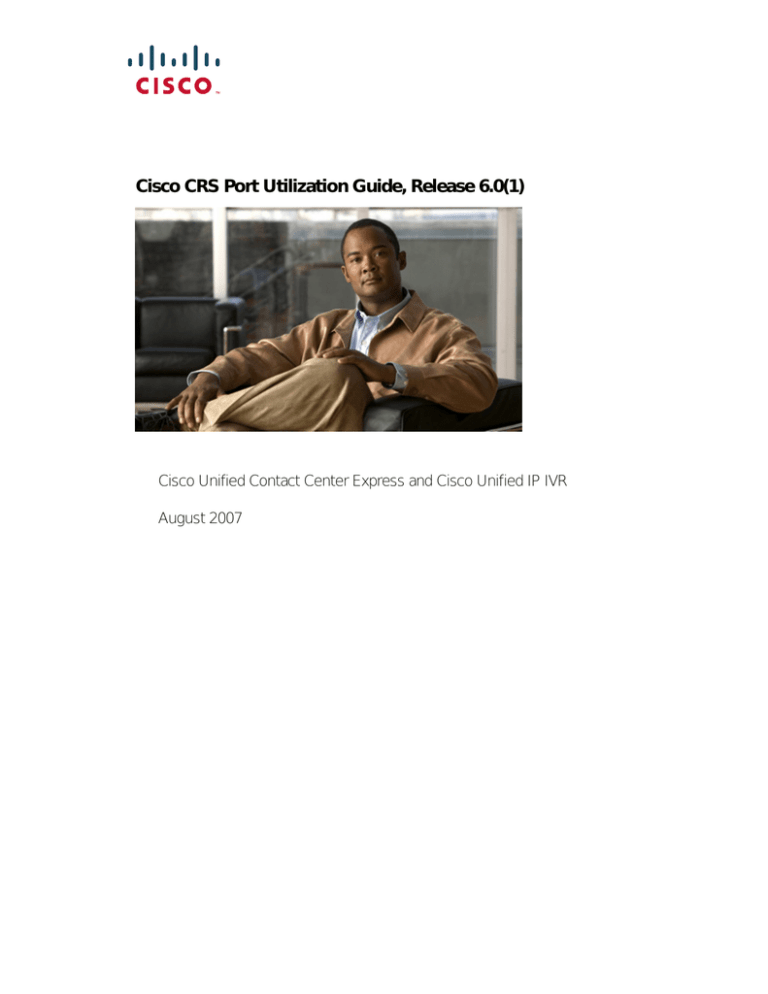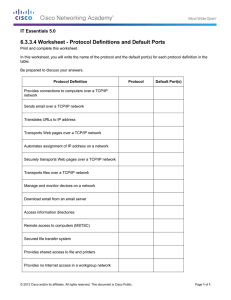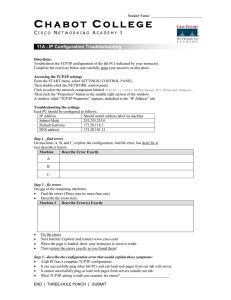
Cisco CRS Port Utilization Guide, Release 6.0(1)
Cisco Unified Contact Center Express and Cisco Unified IP IVR
August 2007
1 Purpose
This document provides a list of the TCP and UDP ports used by Cisco CRS 6.0 (1), includingCisco Unified IP IVR (Unified IP
IVR) and Cisco Unified Contact Center Express (UnifiedCCX).
2 Audience
This document is intended primarily for network administrators.
3 Organization
Port listings are presented in a table format.
4 Related Documentation
For Unified ICME/CCE port utilization information, see the Port Utilization Guide for Cisco Unified ICM/IPCC at
http://www.cisco.com/en/US/products/sw/custcosw/ps1001/products_installation_and_configuration_guides_list.html.
For Unified CRS design infrmation, see the Solution Reference Network Design guide at
http://www.cisco.com/en/US/products/sw/custcosw/ps1846/products_implementation_design_guides_list.html.
5 Port Utilization Table Column Definition
The columns in the Port Utilization tables in this document describe the following:
• Protocol. A value representing a formal description of rules to follow and messages to be used by two or more systems to
exchange information. The protocol is also used to communicate with an application or service listening to or connecting
to a remote device.
• Port. A numeric identifier the Internet transport protocol uses to distinguish among multiple, simultaneous connections to
a single destination host.
• Remote Source Port. An identifier—usually dynamic—for the port the remote application or service uses to connect to the
local destination port.
• Destination Port. An identifier for the TCP or UDP port that the local service or application is listening on, along with the
IP address for incoming connection requests when acting as a server.
• Remote Device Destination Port. The identifier for the TCP or UDP port that the remote device’s service or application is
listening on, along with the IP address for incoming connection requests when acting as the server.
• Remote Device. The remote application or device making a connection to the server or service specified by the protocol.
Note
2
When accessing the Real Time Reporting (RTR) Client on CRS using a browser, the following occurs: The client will
initially communicate to CRS via the pre-configured RMI Port (1099). The CRS server side OS will then determine
what port out of the Ephemeral port range will be used. These have traditionally been between 1024 and 4999 for the
Windows OS. Ephemeral (Dynamic) port range for OS 2000.2.7 and beyond has been changed to 49152 – 65534. This
change was implemented to prevent ports used by Cisco IP Telephony applications from being dynamically assigned
and to bring the OS in alignment with the IANA recommendations. These additional ports have been reserved for
compatibility with some Cisco IP Telephony applications: 57606, 59000-59100, 63432. Previous OS versions used the
Windows 2000 default of 1024 - 4999.
6 Unified IP IVR Port Utilization
Unified IP IVR Port Utilization For Product Revisions: Unified IP IVR 6.0.
Table 1
Unified IP IVR Port Utilization
Protocol
Remote Source
Port
Destination
Port
MS Terminal
Services
TCP 3389
VNC HTTP Helper
TCP 580x
VNC Display
TCP 690x
SMTP
Remote Device
Destination
Port
Remote Device
Notes
Windows Terminal
Services
Remote Control
TCP 25
Virtual Network
Computer Display
Remote Control
Email POP server
Email notification
HTTP
TCP 6293
Administrator Web
browsers
Required for system
maintenance
HTTP
TCP 6294
Unified IP IVR Server
Cluster View Daemon
(CVD)
TCP 994
Unified IP IVR Server
CVD
TCP 996
IP IVR Server
CVD
LDAP
TCP 8404
SVCHOST
DCD Directory on Cisco
Unified CallManager
TCP 135
TCP 135
TCP 789
TCP 789
TCP 1039
TCP 1039
TCP 1042
TCP 1042
SQL server Process
TCP 4433
-
HR Reporting Client
RMI
TCP 1099
TCP 1099
RMI Service
JDBC/SQL
TCP 1433
TCP 1433
Enterprise DataBase Server IP IVR DB Subsystem
TCP 2748
Cisco Unified
CallManager
JTAPI
TCP 8080
User Web Browser/Web
Server
HTTP Trigger/HTTP
Steps
UDP 16384
-32767
IP Phones, IP
Communicator, Voice
Gateways
Voice Media
CTI/QBE
HTTP
RTP
VRU message
interface GED-125
TCP 8080
UDP 16384
-32767
TCP 5000
Windows Service
Loader
Unified IP IVR Main
Server
WFEngineService
Process (Debug Port)
Windows Task
Scheduler
Cisco Unified Contact
Port number is
Center Enterprise VRU PG configurable.
TCP 1444
CiscoWorks
Alarm Service
-
BARS Server
BARS/Upgrade
TCP 4027
BARS Server
BARS/Upgrade
TCP 4127
BARS Server
BARS/Upgrade
TCP 3927
Nuance
3
Table 1
Unified IP IVR Port Utilization
Remote Source
Port
Protocol
Destination
Port
RTSP
RTP/RTCP
UDP 16384
-32767
Remote Device
Destination
Port
Remote Device
TCP 554
Nuance MRCP Speech
Server
UDP 16384
-32767
Nuance MRCP Speech
Server
TCP 4900
Scansoft MRCP Speech
Server
UDP 16384
-32767
Scansoft MRCP Speech
Server
Notes
Scansoft
RTSP
RTP/RTCP
UDP 16384
-32767
7 Unified CCX Port Utilization
Unified CCX Port Utilization for Product Revisions: Unified CCX 6.1
Table 2
Unified CCX Port Utilization
Protocol
Remote Source
Port
Remote Device
Destination
Destination Port Port
Remote Device
MS Terminal
Services
TCP 3389
VNC HTTP Helper
TCP 580x
VNC Display
TCP 690x
SMTP
Notes
Windows Terminal Services
Remote Control
TCP 25
Virtual Network Computer
Display
Remote Control
Email POP server
Email notification
HTTP
TCP 6293
Administrator Web
browsers
Required for system
maintenance
HTTP
TCP 6294
Unified CCX Server
Cluster View Daemon
(CVD)
TCP 994
Unified CCX Server
CVD
TCP 996
Unified CCX Server
CVD
LDAP
SVCHOST
RMI
4
TCP 8404
DCD Directory on Cisco
Unified CallManager
TCP 135
TCP 135
Windows Service
Loader
TCP 789
TCP 789
TCP 1039
TCP 1039
TCP 1042
TCP 1042
SQL Server Process
TCP 4433
-
HR Report Client
TCP 1099
TCP 1099
RMI Server
Unified CCX Main Server
WFEngineService
Process (Debug Port)
Windows Task
Scheduler
Table 2
Unified CCX Port Utilization
Protocol
Remote Source
Port
JDBC / SQL
Remote Device
Destination
Destination Port Port
Remote Device
TCP 1433
TCP 1433
Enterprise DataBase Server
Unified CCX DB
Subsystem
TCP 2748
Cisco Unified CallManager
JTAPI
Phone Agent, User Web
Browser
The Cisco Agent
Desktop agent login
through the phone
display is an IP phone
service linked to an
HTTP trigger on
Unified CCX.
IP Phones, IP
Communicator, Voice
Gateways
Voice Media
Cisco Agent Desktop
(CAD), Unified CCX
Gateway PG
Port number is
configurable.
TCP 2000
Cisco Unified CallManager
Used by the phones
(media termination
and hard phones) to
communicate with
the Cisco Unified
CallManager.
TCP 1444
CiscoWorks
Alarm Service
TCP 3927
BARS Server
BARS/Upgrade
TCP 4027
BARS Server
BARS/Upgrade
TCP 4127
BARS Server
BARS/Upgrade
TCP 59020
Cisco Desktop Chat Service
CTI/QBE
HTTP
RTP
ACMI message
interface; GED-188
Notes
TCP 59010
UDP 16384
–32767
UDP
16384–32767
TCP 42027
SCCP
Cisco Agent Desktop
TCP 38983
TCP 63432
ICMP
-
LDAP Service
CAD and CSD
LRM Service
CAD and CSD
Unified CCX Server
CAD uses ICMP to
constantly check its
communication path
with the Unified CCX
Server.
A customer deploying
a firewall between
CAD and the Unified
CCX server should
not disable ICMP in
the firewall.
5
Table 2
Unified CCX Port Utilization
Protocol
Remote Source
Port
Cisco Supervisor
Desktop
Remote Device
Destination
Destination Port Port
Remote Device
TCP 59000
Notes
Cisco Supervisor Desktop, Cisco Primary server port
Desktop TAI Service
TCP 37350
Cisco Desktop RASCAL
IP discovery port (over
Service, Cisco Supervisor
VPN)
Desktop, Cisco Desktop TAI
Service
Cisco Desktop
Recording and
Statistics Service
RTP
Cisco Desktop
Recording and
Playback Service
Cisco IP Phone
Agent
TCP 59003
Cisco Agent Desktop, Cisco Primary server port
Supervisor Desktop
UDP
59100–59169
Cisco Desktop VoIP
Monitor Service
TCP 59027
Cisco Agent Desktop, Cisco Primary server port
Supervisor Desktop
TCP 59004
Cisco Desktop
Administrator, Cisco Agent
Desktop, Cisco Desktop
TAI Service
Cisco Desktop
Enterprise Service
TCP 59011
Cisco Desktop
Administrator
Cisco Desktop Sync
Service
TCP 59022
Cisco Desktop Chat Service
TCP 59010
Cisco Desktop
Administrator
TCP 6293
IPPA Servlet running under
Tomcat Web Server
Nuance
RTSP
RTP/RTCP
UDP 16384
-32767
TCP 554
Nuance MRCP Speech
Server
UDP 16384
-32767
Nuance MRCP Speech
Server
TCP 4900
Scansoft MRCP Speech
Server
UDP 16384
-32767
Scansoft MRCP Speech
Server
Scansoft
RTSP
RTP/RTCP
6
UDP 16384
-32767
7
Americas Headquarters
Cisco Systems, Inc.
170 West Tasman Drive
San Jose, CA 95134-1706
USA
www.cisco.com
Tel: 408 526-4000
800 553-NETS (6387)
Fax: 408 527-0883
Asia Pacific Headquarters
Cisco Systems, Inc.
168 Robinson Road
#28-01 Capital Tower
Singapore 068912
www.cisco.com
Tel: +65 6317 7777
Fax: +65 6317 7799
Europe Headquarters
Cisco Systems International BV
Haarlerbergpark
Haarlerbergweg 13-19
1101 CH Amsterdam
The Netherlands
www-europe.cisco.com
Tel: 31 0 800 020 0791
Fax: 31 0 20 357 1100
Cisco has more than 200 offices worldwide. Addresses, phone numbers, and fax numbers are listed on the
Cisco Website at www.cisco.com/go/offices.
CCVP, the Cisco logo, and the Cisco Square Bridge logo are trademarks of Cisco Systems, Inc.; Changing the Way We Work, Live, Play, and Learn is a service mark of Cisco Systems, Inc.; and Access Registrar,
Aironet, BPX, Catalyst, CCDA, CCDP, CCIE, CCIP, CCNA, CCNP, CCSP, Cisco, the Cisco Certified Internetwork Expert logo, Cisco IOS, Cisco Press, Cisco Systems, Cisco Systems Capital, the Cisco Systems logo,
Cisco Unity, Enterprise/Solver, EtherChannel, EtherFast, EtherSwitch, Fast Step, Follow Me Browsing, FormShare, GigaDrive, HomeLink, Internet Quotient, IOS, iPhone, IP/TV, iQ Expertise, the iQ logo, iQ Net
Readiness Scorecard, iQuick Study, LightStream, Linksys, MeetingPlace, MGX, Networking Academy, Network Registrar, Packet, PIX, ProConnect, ScriptShare, SMARTnet, StackWise, The Fastest Way to Increase
Your Internet Quotient, and TransPath are registered trademarks of Cisco Systems, Inc. and/or its affiliates in the United States and certain other countries.
All other trademarks mentioned in this document or Website are the property of their respective owners. The use of the word partner does not imply a partnership relationship between Cisco and any other company.
(0705R)
© <year> Cisco Systems, Inc. All rights reserved.
Printed in the USA on recycled paper containing 10% postconsumer waste.
OL-xxxxx-xx
DOC-78xxxxx=




![Computer Networks [Opens in New Window]](http://s3.studylib.net/store/data/008975473_1-426936d686925c93036d8f878e710c04-300x300.png)

